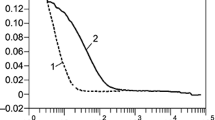Abstract
Measuring the frequency-dependent behaviour of single particles or biological cells in inhomogeneous and/or rotating electric fields is a sensitive method for characterising their dielectric properties. This technique is able to detect broad dispersion in the megahertz range of homogeneous artificial Sephadex G15 spheres. Recent progress has opened up the possibility of carrying out dielectric spectroscopy in cell culture media. Dielectrophoretic and electrorotational spectra of different cells in media of varying conductivity can only be explained by the introduction of dispersive cell compartments. The cytoplasm of animal cells typically exhibits a broad dispersion around 15 MHz and there is evidence for membrane dispersion around 50 MHz.
Similar content being viewed by others
References
Arnold, W. M., Schwan, H. P., and Zimmermann, U. (1987): ‘Surface conductance and other properties of latex particles measured by electrorotation’,J. Phys. Chem.,91, pp. 5093–8
Asami, K., Takahashi, Y., andTakashima, S. (1990): ‘Frequency domain analysis of membrane capacitance of cultured cells (HeLa and myeloma) using the micropipette technique’,Biophys. J.,58, pp. 142–8
Asami, K., andYonezawa, T. (1996): ‘Dielectric behavior of wildtype yeast and vacuole-deficient mutant over a frequency range of 10 kHz to 10 GHz’,Biophys. J.,71, pp. 2192–200
Bao, J.-Z., Christopher, C. D., andSchmukler, R. E., (1993); ‘Impedance spectroscopy of human erythrocytes: System calibration and nonlinear modeling’,IEEE Trans. Biomed. Eng.,40/4, pp. 364–78
Bone, S., Lee, R. S., andHodgson, C. E. (1996): ‘Dielectric studies of intermolecular interactions in native DNA’,Biophys. Biochim. Acta,1306, pp. 93–7
Egger, M., andDonath, E. (1995): ‘Electrorotation measurements of diamide induced platelet activation changes’,Biophys. J.,68, pp. 364–72
Fuhr, G., Glaser, R., andHagedorn, R. (1986): ‘Rotation of dielectrics in a rotating electric high-frequency field’,Biophys. J.,49, pp. 395–402
Fuhr, G., Glasser, H., Müller, T., andSchnelle, Th. (1994): ‘Cell manipulation and cultivation under a.c. electric field influence in highly conductive conductive culture media’,Biophys. Biochim. Acta,1201, pp. 353–60
Fuhr, G., Glasser, H., Schnelle, Th., andShirley, S. G. (1995): ‘Dielectrophoretic field cages: technique for cell, virus and macromolecule handling’,Cell. Eng.,1, pp. 47–57
Fuhr, G., Rösch, P., Müller, T., Dressler, V., andGöring, H. (1990): ‘Dielectric spectroscopy of chloroplasts isolated from higher plants—characterisation of the double-membrane system’,Plant Cell Physiol.,31, pp. 975–85
Fuhr, G., Zimmermann, U., andShirley, L. G. (1996): ‘Cell motion in time-varying fields. principles and potential’ inZimmermann, U. andNeil, G. A. (Eds): ‘Electromanipulation of cells’ (CRC Press, Boca Raton, Florida) pp. 259–328
Gimsa, J., Müller, T., Schnelle, Th., andFuhr, G. (1996): ‘Dielectric spectroscopy of single human erythrocytes at physiological ionic strength: dispersion of the cytoplasm’,Biophys. J.,71, pp. 495–506
Gimsa, J., Schnelle, Th., Zechel, G., andGlaser, R. (1994): ‘Dielectric spectroscopy of human erythrocytes: investigations under the influence of nystatin’,Biophys. J.,66, pp. 1244–53
Grosse, C., andShilov, V. N. (1996): ‘Theory of low frequency electrorotation of polystyrene particles in electrolyte solution’,J. Phys. Chem.,100, pp. 1771–8
Huang, Y., Hölzel, R., Pethig, R., andWang, X.-B. (1992): ‘Difference in AC electrodynamics of viable and nonviable yeast cells determined through combined dielectrophoresis and electrorotation’,Phys. Med. Biol.,37/7, pp. 1499–517
Hölzel, R. (1997): ‘Electrorotation of single yeast cells at frequencies between 100 Hz and 1.6 GHz’,Biophys. J.,73, pp. 1103–8
Hornung, J., Müller, T., andFuhr, G. (1996): ‘Cryoconservation of anchorage-dependent mammalian cells on microstructures and silicon substrates’,Cryobiol.,33, pp. 260–70
Irimajiri, A., Suzaki, T., Asami, K., andHanai, T. (1991): ‘Dielectric modeling of biological cells. Models and Algorithm’,Bull. Inst. Chem. Res. Kyoto Univ.,69/4, pp. 421–38
Jones, T. B. (1995): ‘Electromechanics of particles’ (Cambridge University Press, Cambridge)
Kehle, Th., andHerzog, V. (1989): ‘A colloidal gold labeling technique for the direct determination of the surface area of eukaryotic cells’,Europ. J. Cell Biol.,48, pp. 19–29
Klösgen, B., Reichle, Ch., Kohlsmann, S., andKramer, K. D. (1996): ‘Dielectric spectroscopy as a sensor of membrane head-group mobility and hydration’,Biophys. J.,71, pp. 3250–60
Maier, H. (1997): ‘Electrorotation of colloidal particles and cells depends on surface charge’,Biophys. J.,73, pp. 1617–26
Miura, N., Asaka, N., Shinyashiki, N., andMashimo, S. (1994): ‘Microwave dielectric study on bound water of globule proteins in aqueous solution’,Biopolymers,34, pp. 357–64
Pauly, H., andSchwan, H. P. (1966): ‘Dielectric properties and ion mobility in erythrocytes’,Biophys. J.,6, pp. 621–39
Pethig, R. (1996): ‘Dielectrophoresis: Using inhomogeneous ac electrical fields to separate and manipulate cells’,Crit. Rev. Biotechnol.,16, pp. 331–48
Pethig, R., andKell, D. B. (1987): ‘The passive electric properties of biological systems: their significance in physiology, biophysics and biotechnology’,Phys. Med. Biol.,32/8, pp. 933–70
Pohl, H. A. (1978): ‘Dielectrophoresis’ (Cambridge University Press, Cambridge)
Prüger, B., Eppmann, P., andGimsa, J. (1998): ‘Particle characterisation by AC- electrokinentik phenomena. 3. New developments in electrorotational light scattering (ERLS)’,Coll. Surf. A,136/1–2, pp. 199–207
Schnelle, Th., Glasser, H., andFuhr, G. (1997): ‘An optoelectronic technique for automatic detection of electrorotational spectra of single cells’,Cell. Eng.,2/2, pp. 33–41
Schwan, H. P., andTakashima, S. (1993): ‘Electrical conduction and dielectric behaviour in biological systems’,Encyclopedia Appl. Phys.,5, pp. 177–200
Sukhorukov, V. L., Arnold, W. M., andZimmermann, U. (1993): ‘Hypotonically induced changes in the plasma membrane of cultured mammalian cells’,J. Membr. Biol.,132, pp. 27–40
Sukhorukov, V. L., andZimmermann, U. (1996): ‘Electrorotation of Erythrocytes treated with Dipicrylamine: Mobile charges within the membrane show their “signature” in rotational spectra’,J. Membr. Biol.,153, pp. 161–9
Wang, J., Sukhorukov, V. L., Djuzenova, C. S., Zimmermann, U., Müller, T., andFuhr, G. (1997): ‘Electrorotational spectra of protoplasts generated from the giant marine alga valonia utricularis’,Protoplasma,196, pp. 123–43
Zimmermann, U., Gessner, P., Wander, M., andFoung, S. K. H. (1989): ‘Electroinjection and electrofusion in hypo-osmolar solution’, in:Borrebaeck, C. A. K. andHagen, I. (Eds): ‘Electromanipulation in hybridoma technology’, (Stockton, New York), pp. 1–30
Author information
Authors and Affiliations
Corresponding author
Rights and permissions
About this article
Cite this article
Schnelle, T., Müller, T. & Fuhr, G. Dielectric single particle spectroscopy for measurement of dispersion. Med. Biol. Eng. Comput. 37, 264–271 (1999). https://doi.org/10.1007/BF02513297
Received:
Accepted:
Issue Date:
DOI: https://doi.org/10.1007/BF02513297




